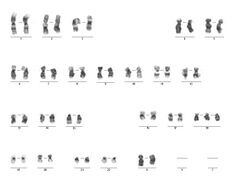Edwards syndrome
Edwards syndrome is a complex genetic syndrome conditioned by the karyotype 47,XX,+18 or 47,XY,+18 (trisomy of chromosome 18).
Newborns are born with numerous congenital developmental defects and malformations of some internal organs. 90 % of those affected die within 12 months of birth. The incidence of this syndrome is 1/5000 births, the probability increases with the age of the mother.
Clinical picture[edit | edit source]
Edwards syndrome manifests itself before birth by intrauterine growth retardation and subsequently low birth weight. The phenotype is variable, with numerous congenital malformations. Craniofacial dysmorphism is characteristic: dolichocephaly (long narrow head), narrow/triangular face, wide/high forehead, hypertelorism (eyes far apart), small mouth, short nose, microretrognacia (small receding chin), protruding occiput, low-set ears. Congenital heart defects (atrial septal defect, ventricular septal defect) and skeletal deformities are typical: permanent finger flexion (camptodactyly), finger deviation. Cryptorchidism, omphalocele is common, short stature and cachexia. Disorders of muscle tone (hypertonus, hypotonus), overall developmental delay, impairment of cognitive functions.[1]
Some children have GIT atresia (esophageal atresia), choanal atresia, cleft palate and lips, congenital diaphragmatic hernia, hydronephrosis, microcephaly and abnormalities of the fontanels and cranial sutures, delayed bone maturation, blepharophimosis, epicanthus, and others.[1]
A typical feature is the so-called "overlapping fingers" – fingers that overlap one another.
Cytogenetic finding[edit | edit source]
Most individuals with Edwards syndrome have 3 copies of chromosome 18 in each cell, due to an error in nondisjunction (in the division of homologous chromosomes in meiotic division I). This leads to an increased number of chromosomes in sex cells. Excess genetic material disrupts the course of normal development and causes the characteristic features of trisomy 18. About 5 % of individuals are affected by the mosaic form, they have a copy of this chromosome only in some body cells. The degree of involvement then corresponds to the number of affected cells.
Therapy and diagnostics[edit | edit source]
Currently, it is not possible to treat Edwards syndrome causally. Treatment is aimed at solving life-threatening problems, especially infections and heart defects.
Thanks to prenatal diagnosis, it is possible to significantly reduce the incidence of Edwards syndrome in newborns. A significant part of the first-trimester and second-trimester screening for birth defects is aimed at detecting an increased risk of chromosomal aberrations – including Edwards syndrome. Using biochemical markers (especially PAPP-A, hCG, significantly reduced values of several different markers are typical) and ultrasound markers(nuchal translucency, the presence of the nasal bone, the length of the femur, etc.) are selected in connection with the mother's age (older maternal age means a higher population risk of chromosomal aberrations) with a higher risk of Edwards syndrome (we are talking about a positive screening). In this case, a consultation with a clinical geneticist is recommended, who can offer one of the invasive examination methods (amniocentesis, chorionic villus sampling, cordocentesis) in order to obtain a sample for examination of the fetal karyotype. Today, so-called quick diagnostics using QFPCR is already possible. Today, trisomy 18 can also be diagnosed using non-invasive genetic tests performed from free fetal DNA from the mother's blood (NIPT). If trisomy 18 is confirmed in the fetus, the pregnant woman is offered an artificial termination of pregnancy. Trisomy of chromosome 18 is also a common cause of spontaneous abortion in the first trimester.
Postnatal diagnosis is again based on the verification of the karyotype of the born child by cytogenetic examination. This syndrome is usually suspected on the basis of a typical clinical picture.
Links[edit | edit source]
Related Articles[edit | edit source]
- Chromosomal abnormalities
- Numerical chromosomal abnormalities
- Syndromes due to aneuploidy of autosomes
References[edit | edit source]
- ↑ a b Genetic and Rare Diseases Information Center. Trisomy 18 [online]. [cit. 2020-11-07]. <https://rarediseases.info.nih.gov/diseases/6321/trisomy-18>.
- GHR, Genetics Home Reference. Trisomy 18 [online]. [cit. 2017-08-05]. <https://ghr.nlm.nih.gov/condition/trisomy-18>.
- NHS UK, National Health Service. Edwards' syndrome (trisomy 18) [online]. [cit. 2017-08-05]. <https://www.nhs.uk/Conditions/edwards-syndrome/Pages/Introduction.aspx>.
Taken from[edit | edit source]
- ŠTEFÁNEK, Jiří. Edwardsův syndrom [online]. [cit. 2009]. <http://www.stefajir.cz>.

